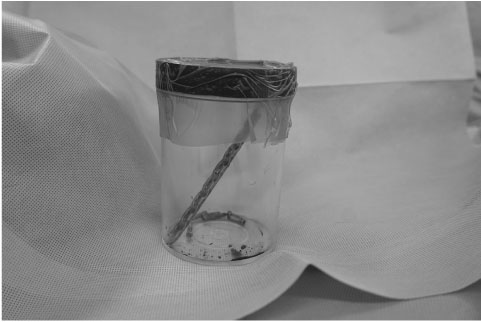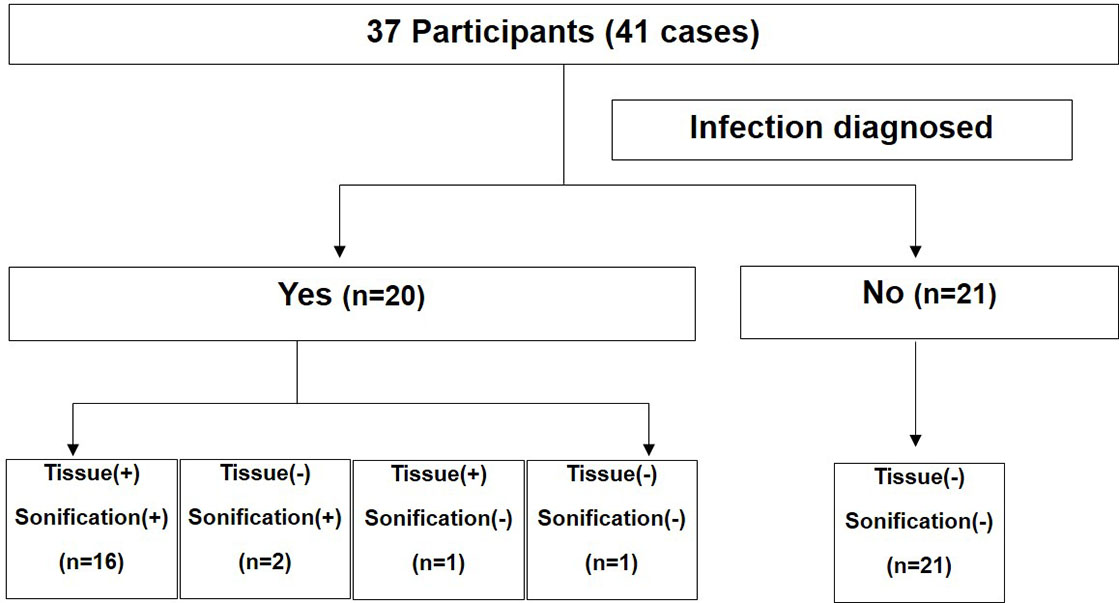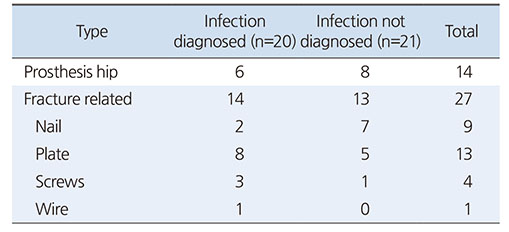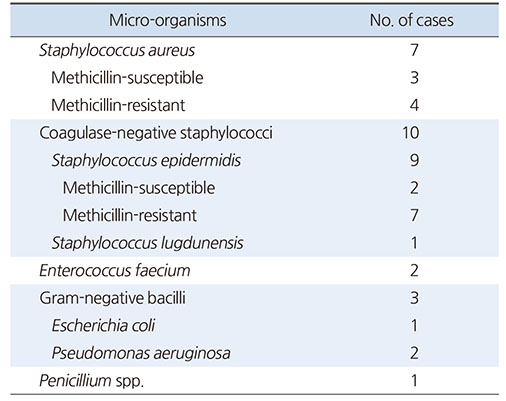Articles
- Page Path
- HOME > J Musculoskelet Trauma > Volume 33(2); 2020 > Article
- Original Article Usefulness of Sonication in Implant-Related Infection
- Jae Hyeon Seo, Mi Na Kim, Ji Wan Kim
-
Journal of Musculoskeletal Trauma 2020;33(2):81-86.
DOI: https://doi.org/10.12671/jkfs.2020.33.2.81
Published online: April 30, 2020

2Departments of Laboratory Medicine, Asan Medical Center, University of Ulsan College of Medicine, Seoul, Korea

- 581 Views
- 1 Download
- 1 Crossref
- 0 Scopus
Abstract
Purpose
This study determined whether the sonication of explants could improve the detection of bacteria and influence the optimal antibiotics treatment.
Materials and Methods
This retrospective study included the patients who underwent implant removal surgery followed by sonication culture as well as tissue culture in order to diagnose implant-related infection. A total of 37 consecutive patients with 41 cases were included. The patients’ demographic data, use of preoperative antibiotics, type of implants, change of antibiotics following the culture results, and recurrence of infection were all reviewed.
Results
Among 41 cases, 20 cases met the diagnostic requirements for implant-related infection as defined by musculoskeletal infection society criteria, while the other 21 cases had explant sonication to exclude indolent infection or residual infection. The latter showed negative results on the both explant cultures and tissue cultures. Among the 20 cases that met the requirements for implant-related infection, 19 cases (95.0%) were identified by any cultures. Of the 19 cases with positive culture results, 2 cases (10.5%) showed positive results only on sonication cultures, and one case (5.3%) showed positive results only on tissue culture. In 1 case of culture negative implant-related infection, a drain sinus was present preoperatively, but the cultures were negative according to both methods. The culture results made postoperative antibiotics change in 12 cases among the 19 culture (+) cases. Antibiotics changes were based on the tissue culture in 2 cases, 2 cases were based on the sonication culture, and the remaining 8 cases were based on both cultures.
Conclusion
The sonication culture improved the diagnosis of implant-related infection combined with conventional tissue culture and helped to determine administering the proper antibiotics.
Published online Apr 28, 2020.
https://doi.org/10.12671/jkfs.2020.33.2.81
Usefulness of Sonication in Implant-Related Infection
Abstract
Purpose
This study determined whether the sonication of explants could improve the detection of bacteria and influence the optimal antibiotics treatment.
Materials and Methods
This retrospective study included the patients who underwent implant removal surgery followed by sonication culture as well as tissue culture in order to diagnose implant-related infection. A total of 37 consecutive patients with 41 cases were included. The patients' demographic data, use of preoperative antibiotics, type of implants, change of antibiotics following the culture results, and recurrence of infection were all reviewed.
Results
Among 41 cases, 20 cases met the diagnostic requirements for implant-related infection as defined by musculoskeletal infection society criteria, while the other 21 cases had explant sonication to exclude indolent infection or residual infection. The latter showed negative results on the both explant cultures and tissue cultures. Among the 20 cases that met the requirements for implant-related infection, 19 cases (95.0%) were identified by any cultures. Of the 19 cases with positive culture results, 2 cases (10.5%) showed positive results only on sonication cultures, and one case (5.3%) showed positive results only on tissue culture. In 1 case of culture negative implant-related infection, a drain sinus was present preoperatively, but the cultures were negative according to both methods. The culture results made postoperative antibiotics change in 12 cases among the 19 culture (+) cases. Antibiotics changes were based on the tissue culture in 2 cases, 2 cases were based on the sonication culture, and the remaining 8 cases were based on both cultures.
Conclusion
The sonication culture improved the diagnosis of implant-related infection combined with conventional tissue culture and helped to determine administering the proper antibiotics.
Fig. 1
An example of sterile containers for the removed implants. To minimize contamination, we sealed the container with sterile surgical drape.
Fig. 2
Flowchart of the enrolled participants and the results of culture.
Table 1
Implants Type
Table 2
Profile of the Microorganisms
Financial support:None.
Conflict of interests:None.
References
-
Metsemakers WJ, Morgenstern M, Senneville E, et al. General treatment principles for fracture-related infection: recommendations from an international expert group. Arch Orthop Trauma Surg. 2019 [doi: 10.1007/s00402-019-03287-4][epub].
-

 E-submission
E-submission KOTA
KOTA TOTA
TOTA TOTS
TOTS






 Cite
Cite

